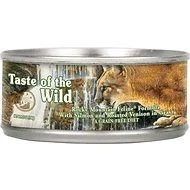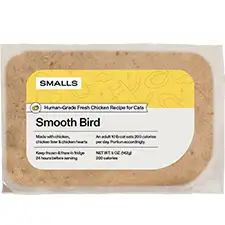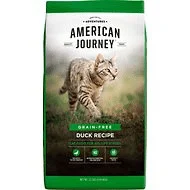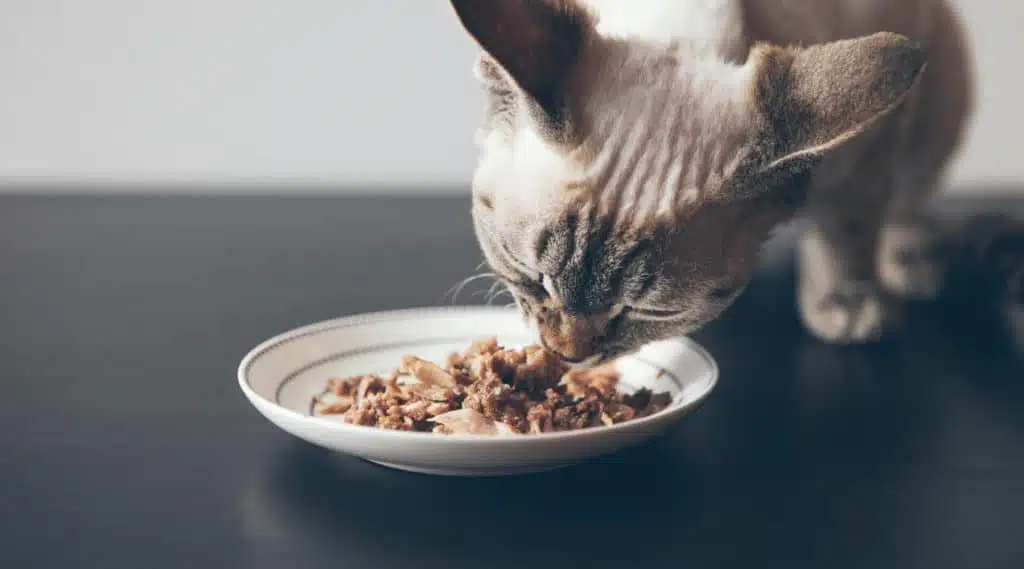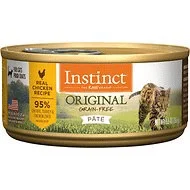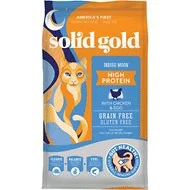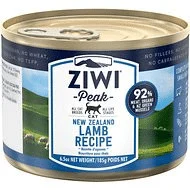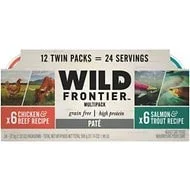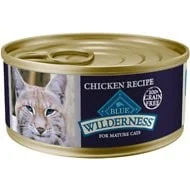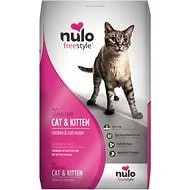9 Best Cat Foods for Weight Gain in Underweight Cats
Quick Guide
- What Is The Best Cat Food For Weight Gain In Underweight Cats?
- What Causes a Cat to Lose Too Much Weight?
- Simple Tips for How to Make a Skinny Cat Gain Weight
- What to Look for in a Good Cat Food for Weight Gain
- How Do We Make Our Recommendations?
- The 9 Best Cat Foods for Weight Gain in Underweight Cats
- Smalls Fresh Bird Human-Grade Cat Food
- Taste of the Wild Rocky Mountain Grain-Free Wet Food
- American Journey Duck Recipe Grain-Free Dry Food
- Instinct by Nature’s Variety Original Grain-Free Real Chicken Recipe Natural Wet Canned Cat Food
- Solid Gold Indigo Moon with Chicken & Eggs Grain-Free High-Protein Dry Cat Food
- Ziwi Peak Lamb Recipe Canned Cat Food
- 3 More Top-Rated Cat Foods for Weight Gain in Underweight Cats
- Frequently Asked Questions
Many pet owners worry about their pets gaining an unhealthy amount of weight. Obesity is a serious health concern in pets, but it isn’t the only possibility – your cat could also be very unhealthy if he is underweight. In fact, unhealthy weight loss becomes an increasingly common problem as cats age.
You love your cat and you want what is best for him, but sometimes it isn’t clear what he needs. If you notice your cat slowly losing weight, you may not think it is a big deal. After all, it is better to be underweight than overweight, right? Not necessarily. Being underweight increases your cat’s risk for malnutrition if he isn’t eating enough. It could also worsen concurrent medical problems like diabetes, kidney disease, and musculoskeletal issues. Regardless the cause, it isn’t something you should ignore.
[sc name=”best-cat-food-underweight-cats-table-code”]In this article, we’ll explore the subject of underweight cats. We’ll review some of the reasons some cats lose too much weight and provide you with some simple tips to help your cat regain a healthy body weight. You’ll also see our recommendations for the best cat food for weight gain.
What Is The Best Cat Food For Weight Gain In Underweight Cats?
- Smalls Fresh Cat Food Delivery
- Taste of the Wild Rocky Mountain Grain-Free
- American Journey Duck Recipe Grain-Free
- Instinct by Nature’s Variety Original Grain-Free
- Solid Gold Indigo Moon with Chicken & Eggs Grain-Free
- Ziwi Peak Lamb Recipe Canned Cat Food
- Nutro Wild Frontier Real Chicken & Beef, Real Salmon & Trout
- Blue Buffalo Wilderness Mature Chicken Recipe
- Nulo Freestyle Chicken & Cod Recipe Grain-Free
What Causes a Cat to Lose Too Much Weight?
Obesity is an increasingly common problem in pets with an estimated 60% of cats and 56% of dogs being overweight or obese. Obesity can increase your cat’s risk for serious health problems and can shave years of his lifespan as well. As bad as obesity is for your cat’s health, being seriously underweight can be just as dangerous. When your cat loses too much weight, it can put him at risk for malnutrition, brittle bones, and other issues.
Before you start to panic about whether your cat is underweight or not, know that there is a simple way to find out. Take a look at your cat from above while he is standing to evaluate his body condition. If he is at his ideal weight, he should be well-proportioned with a visible waist behind the ribs and his ribs should be palpable just beneath the skin with minimal fat covering. An underweight cat may have visible ribs and a severe abdominal tuck – you may also be able to feel the ribs, lumbar vertebrae, and hip bones just beneath the skin. If you can easily see your cat’s bones, it is a sign that he is too skinny.
If you’re concerned that your cat is too skinny, take him to the vet to determine his true body condition score. From there, your vet can help you determine the underlying cause of your cat’s weight loss.
Here are some of the most common causes of weight loss in cats:
- Kidney disease
- Diabetes
- Irritable bowel syndrome
- Dental problems
- Skinny old cat syndrome (SOCS)
Kidney disease and diabetes are fairly common in older cats and they can suppress the cat’s appetite, making problems with weight loss even worse. Protein is an important element in addressing these issues, but it needs to come from a highly digestible animal source. High-protein diets where most of the protein comes from plant sources can exacerbate kidney problems. You may also want to monitor the phosphorus content of your cat’s food if he has kidney issues and switch to a low-starch diet if your cat is suffering from diabetes. You’ll also need to monitor his blood sugar levels.
Cats with digestive issues often have trouble absorbing nutrients. Irritable bowel syndrome can lead to recurrent digestive issues like diarrhea which can then contribute to dehydration, making your cat’s health problems worse. A diet made from high-quality, natural ingredients is the best treatment for digestive issues in cats that are not directly linked to an underlying disease.
In cases where your cat’s weight loss is not linked to some kind of disease, it may simply be due to age. Senior cats are at risk for dental disease which can lead to dental pain or tooth loss, making it more difficult for the cat to eat. More than 50% of cats over the age of three have some degree of dental disease, so if your cat is a senior, he very likely has some kind of dental problems. In other cases, his weight loss may simply be due to Skinny Old Cat Syndrome (SOCS). As your cat gets older, his needs for protein actually increase. If you’re feeding him a high-carb diet, he may not be getting the protein he needs to maintain lean muscle mass which can lead to weight loss.
Now that you have a better understanding of what causes a cat to lose too much weight, you may be wondering how to make a skinny cat gain weight to improve his health. In the next section, we’ll talk about some simple tips for helping your cat gain weight and provide recommendations for cat food.
Simple Tips for How to Make a Skinny Cat Gain Weight
Cats tend to be picky. They’re picky about the places they like to sleep, about the people they let pet them, and they’re picky about what they eat. For some cats, that pickiness leads to low food intake which can lead to unhealthy weight loss over time. Now that you understand a little more about what causes cats to be underweight, you’re ready to learn how to remedy the problem.
Here are some simple tips for helping an underweight cat gain weight:
- Try switching to a different cat food flavor. Sometimes cats stop eating when they become bored with their current diet – making a switch could boost your cat’s appetite.
- Add warm broth to your cat’s food to add flavor and moisture. Some cats have trouble eating dry food or find it unappetizing – warm broth can make it easier to eat and more flavorful.
- Switch to a higher quality cat food so your cat’s body can more easily digest the ingredients and absorb their nutrients – fresh food is a great option.
- Put your cat on a regular feeding schedule to encourage him to eat at mealtime – have two or three scheduled feedings a day and only leave the food out for 15 to 20 minutes.
- Try breaking up your cat’s daily feeding into three or four smaller meals if he has trouble eating a lot of food at once.
- Add a flavorful food topper to your cat’s food – look for moist and semi-moist options or you could even add some cooked chicken to entice your cat’s appetite.
Helping your underweight cat gain weight is about more than just feeding him more of his current food. If your cat is losing weight, it could be partially due to the food you are feeding him! He might have a food allergy that prevents him from properly absorbing calories and nutrition, or he could be eating less of the food than he should be simply because he doesn’t like it.
No matter the reason, switching your cat to a higher calorie food is a good step toward helping him achieve a healthy body weight. Read on to learn what to look for in a good cat food for weight gain.
What to Look for in a Good Cat Food for Weight Gain
Cats are obligate carnivores which means that they have a biological requirement for a high-protein diet. Not just any protein, either – it needs to be high-quality animal protein. Animal proteins like poultry, meat, and fish are considered complete proteins which means that they contain all of the essential amino acids your cat needs to build and maintain lean muscle mass. In the wild, more than 50% of a cat’s diet comes from protein. Research suggests that older cats may lose weight on a diet that contains less than 36% protein. So, the higher the protein content of your cat’s new food, the better.
Here are some of the things we look for in a good cat food for weight gain:
- High-quality sources of animal protein. Your cat’s new food should ideally contain at least 50% protein but, at minimum, 36%. This protein should come from whole animal sources like meat, poultry, and fish.
- Look for higher fat content. Fat is the most concentrated source of calories in your cat’s diet, so higher fat content should help your cat gain weight. Look for recipes that contains 22% to 28% fat, ideally from mostly animal-based sources like chicken fat and fish oil.
- Wholesome, natural ingredients. The more natural your cat’s diet is, the easier it will be for him to digest it and absorb the nutrients. Artificial additives, by-products, and fillers will only interfere with your cat’s digestion and will not provide a valuable source of nutrients or calories.
- Limited starch and carbohydrate content. The average cat food contains 15% to 30% starch, but the ideal level is under 10%. Look for a recipe that contains limited amounts of digestible carbohydrates such as whole grains, fruits, and vegetables.
- Beneficial supplements. In addition to high-quality natural ingredients, you should also be looking for beneficial supplements. Prebiotic fiber and probiotics can boost your cat’s digestion for improved nutrient absorption. Chelated minerals are also good because they are chemically bound to protein molecules which increase their absorption.
Now that you know what to look for in a good cat food for weight gain, you’re ready to start shopping! If you’re still not quite sure where to start, you’ll be glad to see our recommendations below. Before you check them out, however, take a moment to learn exactly how we evaluate different cat food brands to make our recommendations.
How Do We Make Our Recommendations?
There is a great deal of misinformation out there regarding cat food and cat nutrition. Some of the most popular brands of cat food are far from being the best in terms of quality, though the people who buy them are probably unaware of it. Quality nutrition is just as important for your cat as it is for you, so don’t take the task of selecting a cat food lightly. We certainly don’t!
Any cat food that we recommend is one that we would be happy feeding our own cats. We look for cat foods that use high-quality sources of animal protein with a low concentration of carbohydrates. We also favor recipes that are highly digestible and free from artificial additives, fillers, and by-products.
Here are some of the requirements for a cat food to receive our recommendation:
- A source of high-quality animal protein as the first ingredient
- At least 30% crude protein for kittens and at least 26% for adults
- A minimum of 9% crude fat for kittens and adults
- A balance of omega-3 and omega-6 fatty acids, primarily from animal sources
- A rich blend of nutrients from natural sources and supplements, as needed
- Limited carbohydrate content from digestible sources (like whole grains and veggies)
- No low-quality fillers, by-products, or artificial additives (preservatives, dyes, or flavors)
The 9 Best Cat Foods for Weight Gain in Underweight Cats
Healthy weight gain in cats is about more than just feeding your cat more. If you want your underweight cat to put on pounds, you need to choose a recipe that has a higher concentration of calories but also keep in mind that quality matters. Cat foods made with high-quality, natural ingredients are more digestible for your cat which means that he’ll be absorbing more nutrients along with those extra calories. To get you started in shopping for a new recipe, here are our top picks for food for weight gain:
Smalls Fresh Bird Human-Grade Cat Food
Overall Best Cat Food for Weight Gain: When it comes to helping an underweight cat gain weight, it isn’t just about calories. Though increasing your cat’s calorie intake is important, the quality of his diet matters more. It won’t do your cat any good to feed him a large volume of unhealthy food because his body won’t be able to digest it properly and he won’t get the nutrients he needs. High-quality nutrition from fresh, whole-food ingredients is the best diet for underweight cats and that’s exactly what Smalls has to offer.
Smalls is fresh pet food delivered right to your door. You simply fill out a profile for your cat on the website, providing key information such as his name, age, and body weight. You can also indicate whether your cat is an ideal weight or if he needs to gain/lose a few pounds. Smalls takes that information and creates a custom meal plan for your cat, sending you regular deliveries of pre-portioned meals customized to your cat’s calorie needs. If you indicate that your cat needs to gain weight, his meals will be higher in calories to accommodate for that need. Every recipe is made with a premium source of animal protein as the main ingredient with other natural ingredients to follow.
- Pros: High-quality nutrition, rich in premium animal protein, calorie content customized to your cat’s needs, fresh food delivered to your door, wholesome natural ingredients
- Cons: Significantly more expensive than kibble, only two recipe options to choose from
Taste of the Wild Rocky Mountain Grain-Free Wet Food
Most Popular Cat Food for Weight Gain: There are many options for cat food out there, so choosing the right one for your cat can be difficult. There may not even be a “perfect” recipe out there which makes the search that much more difficult. If you’re looking for a recipe from a trustworthy brand, we recommend Taste of the Wild. This brand features premium roasted meats in all of their recipes paired with healthy fats and highly digestible sources of grain-free carbohydrates. This Rocky Mountain Grain-Free Wet Food offers the highest concentration of calories for the brand’s cat food options, coming in at 149 calories per 5.5-ounce can (the average is between 120 and 190 calories per can). This recipe features fresh salmon as the primary ingredient, a rich source of protein and healthy fats. It also contains fish broth and chicken broth for moisture and natural flavor, boosted by protein- and flavor-rich ingredients like chicken liver and fresh chicken. This recipe contains a dry matter calculation of 44% protein and nearly 17% fat.
- Pros: Rich in premium animal proteins, plenty of natural flavor and moisture, highly digestible ingredients, supplemented with chelated minerals, grain-free carbohydrates
- Cons: Could be higher in fat content, may be too high in fiber for some cats
American Journey Duck Recipe Grain-Free Dry Food
Most Affordable Cat Food for Weight Gain: Cat foods for specialized diets can cost a pretty penny. If you’re looking for a cat food recipe that is affordable but still high in quality, consider the American Journey brand. This particular recipe features fresh duck as the main ingredient which is a rich source of premium animal protein and a high-fat protein at that. This recipe also contains chicken meal, duck meal, and menhaden fish meal as supplemental proteins for a total protein content of 40%. You’ll also find several sources of healthy fat in this recipe such as chicken fat and flaxseeds. This recipe is complete and balanced with the help of vitamin supplements and chelated minerals, not to mention probiotic supplements to support healthy and regular digestion. Plus, at 410 calories per cup, this recipe is slightly above average in calorie content for a cat food (the average cat food is about 350 to 400 calories).
- Pros: Rich in premium animal protein, healthy animal-based fats, slightly above average calorie content, wholesome natural ingredients, highly digestible with probiotics, chelated minerals
- Cons: Contains some plant protein (pea protein), could be higher in calorie content
Instinct by Nature’s Variety Original Grain-Free Real Chicken Recipe Natural Wet Canned Cat Food
Best Canned Cat Food for Weight Gain: In many cases, cats who have difficulty eating tend to lose weight. Whether they are suffering from dental problems or poor appetite, these cats may benefit from switching to a canned food instead of a dry cat food. If you’re looking for the best canned cat food for weight gain, we recommend this chicken recipe from Instinct by Nature’s Variety. This formula features fresh chicken and turkey as the top two ingredients, followed by chicken liver and chicken broth as rich sources of natural flavor and moisture. Being high in moisture and loaded with meat flavor, this recipe should be enticing to even the pickiest cats and, because it is made from wholesome natural ingredients, it will be highly nutritious and easy to digest. It contains 193 calories per 5.5-ounce can and contains a dry matter calculation of 45% protein and 34% fat. It also contains fresh fruits and veggies as natural sources for key nutrients.
- Pros: Rich in animal protein and flavor, high-quality natural ingredients, high in protein and calories, plenty of healthy fat, fresh fruits and vegetables
- Cons: May be too high in fiber for some cats, main source of fat is plant-based (flaxseed)
Solid Gold Indigo Moon with Chicken & Eggs Grain-Free High-Protein Dry Cat Food
Best Dry Cat Food for Weight Gain: Many pet parents prefer to feed their cats kibble because it is more affordable, for the most part, and has a longer shelf life than canned food after opening. To help your underweight cat gain weight, one of our top picks for the best high calorie dry cat food is this Solid Gold Indigo Moon with Chicken & Eggs Grain-Free High-Protein Dry Cat Food. Recently reformulated, this recipe contains 475 calories per cup and a whopping 42% protein and 20% fat. The main ingredient is chicken meal, a highly concentrated source of animal protein with a blend of canola oil and fish oil for healthy fats. You’ll also find an assortment of fresh fruits and vegetables, including grain-free carbohydrates, to provide natural sources for key nutrients.
- Pros: High in animal protein, rich blend of omega fatty acids, wholesome natural ingredients, easy to digest with probiotic supplements, chelated minerals
- Cons: Main source of fat is plant-based (canola oil)
Ziwi Peak Lamb Recipe Canned Cat Food
Best Cat Food for Weight Gain and Sensitive Stomach: Food allergies and sensitivities can cause a cat to lose weight if he has trouble digesting food. In many cases, food allergies are caused by low-quality ingredients and by-products, but some cats are allergic or sensitive to common proteins like chicken or beef. If you’re looking for a good food to boost your cat’s protein and calorie intake without triggering allergies or sensitivities, try this Ziwi Peak Lamb Recipe Canned Food. It features lamb as a single source of premium animal protein with limited carbohydrate content and plenty of natural flavor. It contains a dry matter calculation of 43% protein and 27% fat.
- Pros: Single source of premium animal protein, rich in healthy fats, low in carbohydrate content, full of real meat flavor, complete and balanced, chelated minerals
- Cons: Somewhat expensive compared to average wet food
3 More Top-Rated Cat Foods for Weight Gain in Underweight Cats
Just about any cat food can help your cat gain weight if you feed him the proper amount. The trouble with many underweight cats, however, is that they don’t have much of an appetite or they have problems that prevent them from eating large volumes of food. In cases like this, it is important to choose a cat food that is very calorie-dense, so your cat gets the recommended number of calories in a smaller and more manageable portion size. Here are some additional recommendations:
Nutro Wild Frontier Real Chicken & Beef, Real Salmon & Trout Multipack Adult Canned Food
Some cats become more picky about the food they eat over time which makes your job more difficult. If you’re looking for a good cat food for weight gain that will also give your cat the variety he craves, try this multipack from Nutro Wild Frontier. This multipack contains two recipes, one featuring chicken and beef, the other featuring salmon and trout. Both recipes are packed with premium animal proteins and natural meat flavor, plus a rich blend of omega fatty acids. You’ll also find that they are supplemented with vitamins and minerals to ensure complete and balanced nutrition. These wet food recipes contain an average dry matter calculation of 56% protein and nearly 30% fat.
Blue Buffalo Wilderness Mature Chicken Recipe Grain-Free Canned Food
Many cats lose weight as they get older, so you might be looking for a high calorie wet cat food for senior cats to help your cat regain a healthy body weight. We recommend this Blue Buffalo Wilderness Mature Chicken Recipe canned food because it is rich in premium animal protein, high in calories, and loaded with wholesome natural ingredients. It contains plenty of fiber for healthy digestion with chelated minerals to ensure optimal nutrient absorption. Overall, this recipe contains a dry matter calculation of 36% protein and nearly 25% fat.
Nulo Freestyle Chicken & Cod Recipe Grain-Free Dry Cat & Kitten Food
Another option in the best dry cat food for weight gain is this Nulo Freestyle recipe. It is formulated for complete and balanced nutrition in both kittens and adults, so you won’t have to switch your kitten to another recipe when he grows up. It features fresh chicken as the first ingredient with chicken meal, turkey meal, and deboned cod to follow. It is rich in omega fatty acids and contains fresh fruits and vegetables as natural sources for key nutrients. Overall, this formula contains 486 calories per cup with 40% crude protein and 20% fat.
Frequently Asked Questions
- How much should I feed my underweight cat? There is no one-size-fits-all answer to this question because it depends entirely on your cat. The amount of food your cat needs depends on his calorie requirements, determined by his age, bodyweight, and activity level. The calorie contents of cat foods differ, however, so the actual amount of food your cat eats will be determined by the individual recipe. If your cat is underweight, try feeding him the amount recommended for a cat a few pounds heavier than he currently is. The additional calories should help your cat gain weight, assuming there aren’t any underlying health problems.
- Why is my cat so skinny when he eats all the time? There are a number of health problems that can cause a cat to lose weight or have trouble gaining weight despite eating a normal amount. Hyperthyroidism is a condition that commonly causes extreme hunger paired with weight loss. Other conditions like diabetes and kidney failure can cause weight loss, especially in senior cats. If you notice that your cat is losing weight despite eating a normal amount of food, talk to your veterinarian as soon as possible.
- How many calories should a cat eat to gain weight? For healthy cats, the number of calories needed each day varies according to age, weight, and activity level. When you read the feeding recommendations on a bag of cat food, the amount given is calculated with consideration for the calorie content of that specific food. Keep in mind as well that these recommendations are given to help your cat maintain his current weight. For most cats, the average is about 20 calories per pound of body weight. If you want your cat to gain weight, you’ll need to feed him a higher number of calories. Either buy a cat food formulated specifically for weight gain, or simply start feeding him the amount of food recommended for a cat that weighs his target weight.
- How much should a cat eat a day? The answer to this question depends on a number of factors. First and foremost, the amount of food your cat should eat depends on the calorie content of the food. If you choose a high calorie cat food, your cat may not need to eat as much as he would of a lower calorie cat food. For underweight cats, you may find yourself feeding your cat more than the average cat, both in terms of food quantity and calorie content. Refer to the feeding instructions on the cat food label and check how much to feed a cat the same age and weight as your cat. If your cat needs to gain weight, check the feeding amount for a cat that weighs your cat’s target weight and feed him that amount.
- How many times a day should I feed my cat? Kittens grow very quickly between the time of birth until they reach about 6 months old. During this time period, you should keep your kitten’s food bowl full so he can eat as much as he needs to. This is the best way to ensure that your cat grows and develops at the proper rate. Once your kitten reaches 6 months, however, you may want to switch to measured feedings to prevent him from gaining an unhealthy amount of weight. Refer to the feeding instructions on the package and divide the daily amount into two or three feedings. If you’re trying to help an adult cat gain weight, you may need to give your cat an extra meal each day.
Though humans are obsessed with weight loss, losing weight can be very unhealthy for a cat. Considering that cats are much smaller than dogs, a loss of only one or two pounds can be significant. Being underweight can affect your cat’s health and wellness, so don’t ignore the signs and take steps immediately to help your cat return to a healthy bodyweight.
Use the information provided above to determine whether your cat needs to gain weight and consider the tips given to help him do it. If you’re looking for a new higher calorie food to feed your cat, consider some of the options reviewed above. Good luck!


